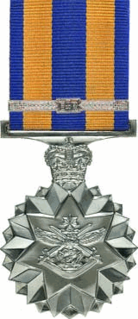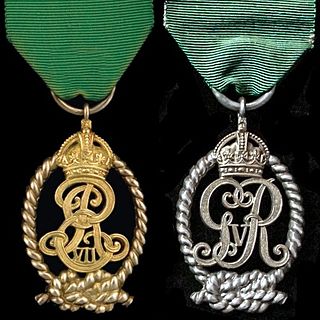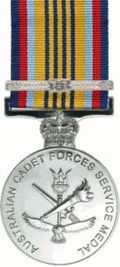
The Queen Elizabeth II Golden Jubilee Medal or the Queen's Golden Jubilee Medal was a commemorative medal created in 2002 to mark the fiftieth anniversary of Elizabeth II's accession. The Queen Elizabeth II Golden Jubilee Medal was awarded in Canada to nominees who contributed to public life. The Queen's Golden Jubilee Medal was awarded to active personnel in the British Armed Forces and Emergency Personnel who had completed 5 years of qualifying service.

The Gulf War Medal was a campaign medal approved in 1992, for issue to officers and men of British forces who served in Kuwait and Saudi Arabia during Operation Granby in 1990–91.
The Conspicuous Service Medal (CSM) is a military decoration awarded to personnel of the Australian Defence Force, and officers and instructors of the Australian Defence Force Cadets. It is awarded for meritorious achievement or dedication to duty in non-war like situations. The CSM was introduced in 1989 and is a distinct Australian military award. It is the second level award of the Conspicuous Service Decorations in the Australian Honours System. Recipients of the Conspicuous Service Medal are entitled to use the post-nominal letters "CSM". Since its inception 1,021 had been awarded, plus a single Bar. All ranks are eligible for the award.

The Reserve Force Decoration is an Australian Military award given for long service by officers of the Reserve Forces. It is part of the suite of defence force service awards introduced in 1982, which also included the Defence Force Service Medal and the Reserve Force Medal. However, the RFD is the only one of the three to carry a postnominal entitlement.

The Afghanistan Medal was instituted by Queen Elizabeth II on the advice of the Australian Prime Minister John Howard in 2004. It is awarded to Australian defence force personnel who served in or around Afghanistan after 11 October 2001. Defence force personnel are also recognised by the 'ICAT' clasp to the Australian Active Service Medal and the North Atlantic Treaty Organisation's Non-Article 5 Medal with 'ISAF' clasp.

The Defence Force Service Medal (DFSM) is an Australian Military award given for long service by permanent members of the Australian Defence Force. It is part of the suite of defence force service awards introduced in 1982, which also included the Reserve Force Decoration and the Reserve Force Medal.

The Reserve Force Medal (RFM) is an Australian Military award given for long service by non-commissioned members of the Reserve Forces. It is part of the suite of defence force service awards introduced in 1982, which also included the Defence Force Service Medal and the Reserve Force Decoration.

The Defence Long Service Medal is an Australian military award given for long service by permanent and reserve members of the Australian Defence Force (ADF), irrespective of rank. It was introduced in 1998, and replaced the suite of ADF service awards introduced in 1982, which comprised the Defence Force Service Medal, the Reserve Force Medal and the Reserve Force Decoration.

The Anniversary of National Service 1951–1972 Medal is a commemorative medal awarded to Australians for their service in post-war national service schemes.

The Decoration for Officers of the Royal Naval Volunteer Reserve, post-nominal letters VD until c. 1947 and VRD thereafter, was instituted in 1908. It could be awarded to part-time commissioned officers in the United Kingdom's Royal Naval Volunteer Reserve after twenty years of service as efficient and thoroughly capable officers. The decoration was a Naval version of the Volunteer Officers' Decoration and its successor, the Territorial Decoration.

The Australian Active Service Medal 1945–1975 recognises the service of Australian Defence Force and certain other persons in prescribed warlike operations in the period after World War II, and prior to February 1975. The medal was established in December 1997. The Australian Active Service Medal recognises warlike service after February 1975 until 2012 when the Australian Operational Service Medal was instituted.

The Australian Service Medal 1945–1975 recognises service in peacekeeping or non-warlike operations in the 30-year period following World War II, and prior to February 1975. The medal was established on 22 February 1995. The Australian Service Medal recognises non-warlike service after February 1975.

The International Force East Timor (INTERFET) Medal recognises members of the Australian Defence Force who served for 30 days in East Timor during the INTERFET campaign. The qualifying area comprises East Timor and the sea adjacent to East Timor out to a distance of 12 nautical miles (22 km) from the low water mark.

The Rhodesia Medal was initiated by the British Government in consultation with Australia, New Zealand, Fiji and Kenya, whose forces took part in Operation AGILA. The role of the multi-national force was to keep peace between 22,000 guerrilla fighters and the Rhodesian forces during the ceasefire and run-up to the 1980 elections.

The Cadet Forces Medal is awarded to recognise long and efficient service by Commissioned Officers and non commissioned adult instructors of the UK Cadet Forces: The Army Cadet Force, the RAFAC Air Training Corps, the Sea Cadets and Combined Cadet Force, and Commissioned Officers of the New Zealand Cadet Forces. Authorised by a Royal warrant it is awarded for 12 years service or when commissioned. Additional clasps are issued for every 8 years additional service in New Zealand & for 6 additional years in the UK.

The Efficiency Decoration, post-nominal letters TD for recipients serving in the Territorial Army of the United Kingdom or ED for those serving in the Auxiliary Military Forces, was instituted in 1930 for award to part-time officers after twenty years of service as an efficient and thoroughly capable officer. The decoration superseded the Volunteer Officers' Decoration, the Colonial Auxiliary Forces Officers' Decoration and the Territorial Decoration.

The National Police Service Medal (NPSM) is a special service award within the Australian honours system to provide "recognition for the unique contribution and significant commitment of those persons who have given ethical and diligent service as a sworn member of an Australian police service".
The Long Service and Good Conduct Medal is a military award recognizing 15 years of exemplary and unblemished service by non-commissioned and other ranks members of the New Zealand Defence Force. Established in 1985, these medals replaced the British Long Service and Good Conduct Medals with specific versions for New Zealand. There are three version of the Long Service and Good Conduct Medal, one each for the New Zealand Army, Royal New Zealand Navy, and the Royal New Zealand Air Force.

The Royal Naval Volunteer Reserve Long Service and Good Conduct Medal, initially designated the Royal Naval Volunteer Reserve Long Service Medal, was instituted in 1908. It could be awarded to part-time ratings in the United Kingdom's Royal Naval Volunteer Reserve after twelve years of service and good conduct. The medal was a Naval version of the Volunteer Long Service Medal and its successor, the Territorial Force Efficiency Medal.

The Northern Ireland Prison Service Medal was established by Royal Warrant on 15 January 2002. Agreed to in principle by the Queen in 2000, the medal was created to recognise Northern Ireland Prison Service personnel who had served in the "difficult and often dangerous conflict" during the Troubles. This included the murder of 28 prison staff, with dozens more wounded and many forced to move home due to intimidation.


















